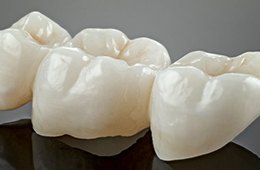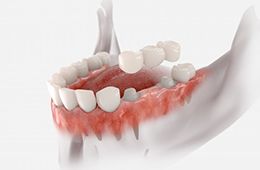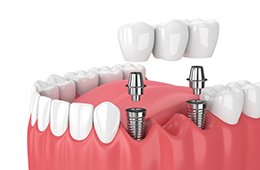Dental Bridges – Campbell, CA
Bridge the Gap in Your Smile

Many people live with one or several sequential missing teeth, making it difficult for them to smile confidently or even give them anxiety about laughing in front of people. Thankfully, dental bridges can close these gaps with beautifully lifelike restorations that complete your smile and restore your self-image. Here’s a brief guide to how dental bridges work, the benefits they offer, and how Dr. Ho can help you achieve a complete smile, but please contact our office if you’d like to learn more.
Why Choose Dr. Karen Ho, DDS, for Dental Bridges?
- Compassionate Dentist with Years of Experience
- Beautiful and Comfortable Restorations
- Financing Options Available
What is a Dental Bridge?

A dental bridge is a row of artificial teeth designed to replace one or several sequential missing teeth. These appliances are made from lifelike materials that imitate the appearance of natural dental structure such as composite resin or ceramics such as porcelain. Almost anyone with one or more missing teeth in a row can be an excellent candidate for a dental bridge if they have healthy gums as well as healthy teeth or sufficiently strong jawbone structure on either side of the gap in their smile. If you are not a good candidate for a dental bridge when you first have your consultation, you may be able to become one later after receiving procedures like gum disease therapy, bone grafts, or tooth decay treatments.
Types of Dental Bridges

Dental bridges can be sorted into two varieties, and which one is best for you depends on your oral health situation and your budget. During your consultation, Dr. Ho will discuss your needs and preferences for the treatment and make an appropriate recommendation.
Traditional Dental Bridge

A traditional dental bridge is one or several artificial teeth strung between two dental crowns. To anchor this appliance in the mouth, the healthy teeth on either side of the gap must be modified to host the crowns supporting the bridge.
Implant Bridge

Implant bridges are several sequential artificial teeth that do not require the alteration of healthy dental structure to be placed. This is because an implant bridge is supported by dental implants placed into the jawbone on either side of the gap, providing a longer-lived restoration as well as superior chewing strength.
The Benefits of Getting a Dental Bridge

The American Dental Association recommends replacing lost teeth as soon as possible to prevent serious oral health consequences such as:
- The neighboring teeth shifting out of alignment
- Diminished self-confidence
- Trouble with speaking and eating
- Increased risk of oral infection and injury
If you believe a dental bridge may be the best way to replace your missing teeth, contact Dr. Ho’s office to schedule a consultation. Our staff will be happy to help you understand your options so you can enjoy a complete and healthy smile.
Dental Bridges FAQs
How Long Should a Dental Bridge Last?
With proper care, you can expect a dental bridge to last for 15 years or more. If you don’t care for your bridge with regular oral hygiene, then bacteria and wear and tear will shorten its lifespan. This might not sound like a big deal at first, but over time, frequent replacements and repairs add up! Here’s what you should do to help your dental bridge last as long as possible:
- Brush your teeth twice daily with a soft bristled toothbrush
- Floss at least once per day
- If you want to go the extra mile, rinse your mouth with warm water after each meal
Make sure you understand how to properly care for your restoration and give us a call if you have questions or need a reminder.
How Do I Clean Under My Dental Bridge?
Great question! While your bridge is designed to fit snuggly and comfortably, bacteria can still get trapped in the space between your restoration and gumline. There are a couple of ways you can clean this area, including:
- Threading floss underneath your bridge, sliding it back and forth to remove bacteria.
- Using an interdental brush, which is smaller than a toothbrush and easier to manipulate.
- Flushing the space with a water flosser.
Water flossers are a relatively new tool, but patients love how pristine their teeth feel after using them, and some studies indicate they’re more effective than traditional thread.
Do Dental Bridges Feel Natural?
At first, your dental bridge might feel a little strange. After all, you’re filling in a dental gap, which in some cases can be rather large! However, it’ll likely start to feel more and more natural within a few days. We craft our bridges from quality materials, which allow them to stand up to chewing and other everyday forces just as well as tooth enamel. Since they’re custom-fitted, your bridge will eventually feel seamless.
If you continue to experience discomfort, though, or if your dental crown doesn’t seem to fit quite right, let us know! We’ll be happy to address the issue and make sure your dental replacement functions as it’s supposed to.
Can Dental Bridges Get Cavities?
The bacteria strain that causes cavities specifically affects natural dental enamel. In other words, the bridge itself can’t develop cavities, but the supporting teeth underneath can. If those pearly whites experience significant decay, your dental bridge could fail, and we might not be able to fit another one over the damage. That’s why it’s so important to brush and floss!
Are Dental Bridges Covered by Insurance?
Yes, and most dental insurance plans cover about 50% of the costs. However, not all policies are the same, so it’s important to double-check your benefits. Limitations like your yearly deductible and annual maximum could also affect your coverage.
We know dental insurance can be confusing, so if you need help navigating your benefits, let us know. We’ll be happy to review your plan and make sure you get the most out of your benefits!
 Call
Call